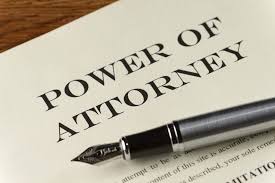
In the first three parts of this blog series, I discussed all the types and details about Powers of Attorney. Now, I want to finally address selecting your POA and creating a POA, and then what to do with it after it’s been created.
Who to Select as a Power of Attorney?
This is absolutely the most important part of the decision. You must be very careful in who you select. A person who is appointed as a POA is called your agent, or attorney-in-fact. This person can sign as though he is you and transaction business as though he is you. His signature on a contact binds you to the contract. He can pull all of the money out of your bank account and go on a Las Vegas, never to be seen again.

It’s not appropriate just to select the eldest child because she is the eldest, or the child who lives closest to you due to proximity.
The person selected should be the most trustworthy, capable, and willing and able to do the job. You should discuss this with the person you are considering selecting before setting up the document. You should prayerfully consider this decision, with careful judgment.
If you’re married, a spouse is often primary. A child, or other trusted friend or family member would be next in line as an alternate.
You can also select more than one person to act as “co-powers of attorney.” Usually, when we set up “co”, we make it “either/or” so that is does not require two signatures to transact business. However, we can set it up to make two signatures mandatory, although that type of POA is harder logistically to use if ever needed.
For someone who does not have a trusted family member or friend, an organization or a bank trust department can also be appointed as a POA.
How to Create a Power of Attorney
 A POA is a created according to the laws of the state of your legal residence. Most of my information here is Indiana-specific. To create a POA in Indiana, the person who wants to create it signs the POA document in front of a notary public. Indiana now has remote notarization, but signing that way is fairly difficult and signing in a notary’s presence is the easiest.
A POA is a created according to the laws of the state of your legal residence. Most of my information here is Indiana-specific. To create a POA in Indiana, the person who wants to create it signs the POA document in front of a notary public. Indiana now has remote notarization, but signing that way is fairly difficult and signing in a notary’s presence is the easiest.
The person signing must have legal capacity—meaning know what they’re signing, understand its implications, and be voluntarily signing it. If a person is too ill, or has too advanced mental decline, it’s too late to sign a POA. A court proceeding for a guardianship might be required.
Physical ability to sign is not an issue. There are ways to deal with physical impairments to signing that still allow that person to create a POA.
The question is where to get POA documents. Not all POA documents are created equal. Some work well and some don’t work at all. This is not a form to download from the internet. It matters specifically what is written in the document and the document is totally customizable. It is not a one-size-fits-all or a standard form.
In the case of POAs, I strongly recommend talking to an attorney and having an attorney prepare the documents. Also, make sure you ask the attorney if he or she works with people who need to use POAs—meaning that attorney gets to see if his POA documents serve his clients well or not.
We normally have our clients sign several original POA documents. It’s handy to have multiple originals, especially if you’re appointment more than one person.
In Part 5, the final part of this blog series on POAs, I’ll address some final issues:
- What do you do with those documents?
- What does the person you’ve appointed as POA need to know?
- What if you want to change your mind? How do you amend or revoke the POA?